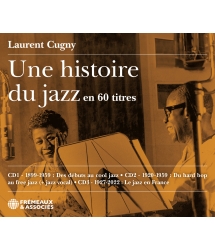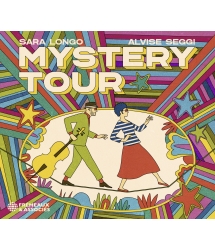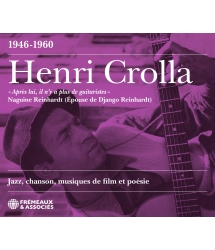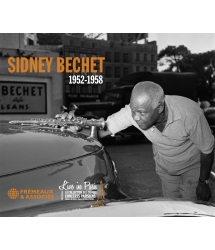- Notre Catalogue
- Philosophie
- Philosophes du XXème siècle et d'aujourd'hui
- Histoire de la philosophie (PUF)
- Contre-Histoire et Brève encyclopédie par Michel Onfray
- L'œuvre philosophique expliquée par Luc Ferry
- La pensée antique
- Les penseurs d'hier vus par les philosophes d'aujourd'hui
- Textes philosophiques historiques interprétés par de grands comédiens
- Histoire
- Livres
- Sciences Humaines
- Paroles historiques
- Livres audio & Littérature
- Notre Catalogue
- Jazz
- Blues - R'n'B - Soul - Gospel
- Rock - Country - Cajun
- Chanson française
- Musiques du monde
- Afrique
- France
- Québec / Canada
- Hawaï
- Antilles
- Caraïbes
- Cuba & Afro-cubain
- Mexique
- Amérique du Sud
- Tango
- Brésil
- Tzigane / Gypsy
- Fado / Portugal
- Flamenco / Espagne
- Yiddish / Israël
- Chine
- Tibet / Népal
- Asie
- Océan indien / Madagascar
- Japon
- Indonésie
- Océanie
- Inde
- Bangladesh
- URSS / Chants communistes
- Musiques du monde / Divers
- Musique classique
- Compositeurs - Musiques de film - B.O.
- Sons de la nature
- Notre Catalogue
- Jeunesse
- Philosophie
- Nouveautés
- Comment commander ?
- Recevoir le catalogue
- Manifeste
- Dictionnaire











- Notre Catalogue
- Philosophie
- Philosophes du XXème siècle et d'aujourd'hui
- Histoire de la philosophie (PUF)
- Contre-Histoire et Brève encyclopédie par Michel Onfray
- L'œuvre philosophique expliquée par Luc Ferry
- La pensée antique
- Les penseurs d'hier vus par les philosophes d'aujourd'hui
- Textes philosophiques historiques interprétés par de grands comédiens
- Histoire
- Livres
- Sciences Humaines
- Paroles historiques
- Livres audio & Littérature
- Notre Catalogue
- Jazz
- Blues - R'n'B - Soul - Gospel
- Rock - Country - Cajun
- Chanson française
- Musiques du monde
- Afrique
- France
- Québec / Canada
- Hawaï
- Antilles
- Caraïbes
- Cuba & Afro-cubain
- Mexique
- Amérique du Sud
- Tango
- Brésil
- Tzigane / Gypsy
- Fado / Portugal
- Flamenco / Espagne
- Yiddish / Israël
- Chine
- Tibet / Népal
- Asie
- Océan indien / Madagascar
- Japon
- Indonésie
- Océanie
- Inde
- Bangladesh
- URSS / Chants communistes
- Musiques du monde / Divers
- Musique classique
- Compositeurs - Musiques de film - B.O.
- Sons de la nature
- Notre Catalogue
- Jeunesse
- Philosophie
- Nouveautés
- Comment commander ?
- Recevoir le catalogue
- Manifeste
- Dictionnaire
CONTAINS 20 PREVIOUSLY UNRELEASED TRACKS AND 7 BONUS TRACKS
RAY CHARLES
Ref.: FA5811
Direction Artistique : JOEL DUFOUR
Label : Frémeaux & Associés
Durée totale de l'œuvre : 3 heures 49 minutes
Nbre. CD : 3
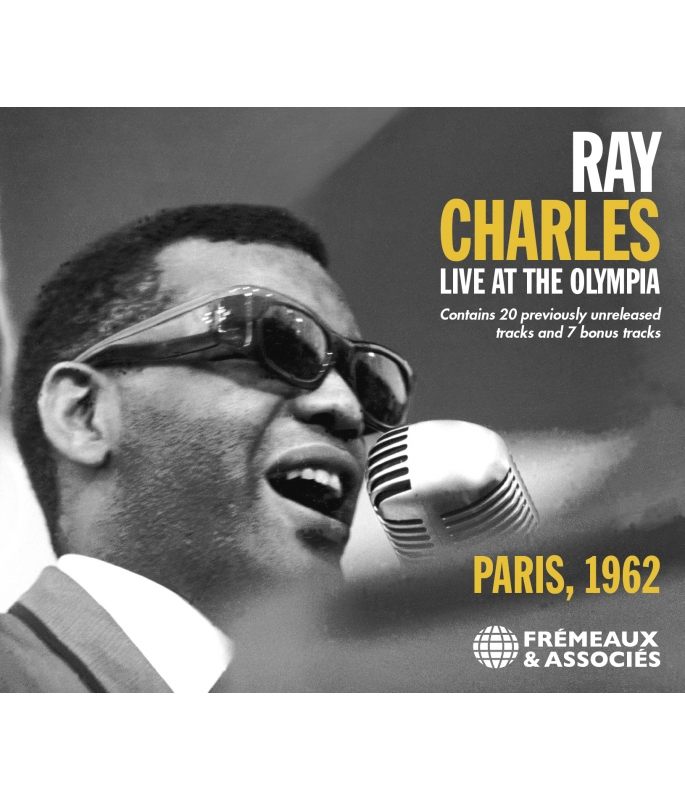
CONTAINS 20 PREVIOUSLY UNRELEASED TRACKS AND 7 BONUS TRACKS
- - SOULBAG ****
- - Jazz Magazine
- - CHOC Classica
Du 17 au 25 mai 1962 Ray Charles retourne à Paris pour une série de concerts mémorables. Le Genius, accompagné de son big band et de ses Raelets menées par l’éblouissante Margie Hendrix, est au sommet de son art. Conçu par Joël Dufour, réalisé avec le soutien de Michel Brillié et Gilles Pétard, ce coffret 3 CD présente des inédits et bonus, dont des enregistrements studio sur le propre label de Ray Charles, où il accompagne au piano ses artistes favoris : Percy Mayfield et Louis Jordan. Enfin, « Blue Stone », sa grande oeuvre instrumentale au sax alto, qu’il n’a jamais enregistrée en studio, est le joyau rare de cet album.
Patrick FRÉMEAUX
CD 1 : MOANIN’ • ONE MINT JULEP • LET THE GOOD TIMES ROLL • GEORGIA ON MY MIND • HIDE NOR HAIR • CARELESS LOVE • HALLELUJAH I LOVE HER SO • THE DANGER ZONE • MARIE • ALEXANDER’S RAGTIME BAND • I BELIEVE TO MY SOUL • HIT THE ROAD JACK • MY BONNIE • UNCHAIN MY HEART • BYE BYE LOVE • DROWN IN MY OWN TEARS • YES INDEED • WHAT’D I SAY. RAY CHARLES BONUS TRACKS: (NIGHT TIME IS) THE RIGHT TIME [ALTERNATE STUDIO TAKE] • CARELESS LOVE [ALTERNATE STUDIO TAKE]. BONUS TRACK WITH RAY CHARLES ON PIANO: PERCY MAYFIELD: COOKIN’ IN STYLE [MASTER TAKE].
CD 2 : BLUE STONE • FROM THE HEART • ONE MINT JULEP • LET THE GOOD TIMES ROLL • GEORGIA ON MY MIND • MARGIE • I’VE GOT A WOMAN • THE DANGER ZONE • HALLELUJAH I LOVE HER SO • CARELESS LOVE • JUST A LITTLE LOVIN’ • YOU DON’T KNOW ME • HIDE NOR HAIR • COME RAIN OR COME SHINE • TELL THE TRUTH • WHAT’D I SAY. BONUS TRACKS WITH RAY CHARLES ON PIANO: LOUIS JORDAN: HARDHEAD • LOUIS JORDAN: WORKIN’ MAN • LOUIS JORDAN: TEXARKANA TWIST • LOUIS JORDAN: YOU’RE MY MULE.
CD 3 : DOODLIN’ • ONE MINT JULEP • LET THE GOOD TIMES ROLL • GEORGIA ON MY MIND • MARGIE • CARELESS LOVE • HALLELUJAH I LOVE HER SO • UNTITLED BLUES • ALEXANDER’S RAGTIME BAND • I CAN’T STOP LOVING YOU • (NIGHT TIME IS) THE RIGHT TIME • HIT THE ROAD JACK • I BELIEVE TO MY SOUL • MY BONNIE • UNCHAIN MY HEART • BYE BYE LOVE • YES INDEED • WHAT’D I SAY. RAY CHARLES BONUS TRACK: SWINGIN’ ALONG.
DIRECTION ARTISTIQUE : JOËL DUFOUR
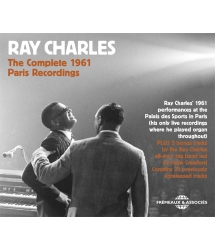
THE ONLY LIVE RECORDINGS WHERE RAY CHARLES PLAYED...
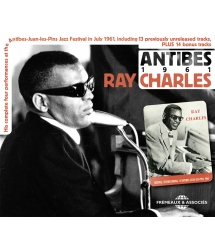
INCLUDING 13 PREVIOUSLY UNRELEASED TRACKS, PLUS 14...
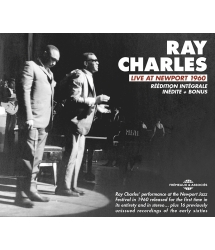
RÉÉDITION INTÉGRALE INÉDITE + BONUS

INTEGRALE 1959-1962




-
PisteTitreArtiste principalAuteurDuréeEnregistré en
-
1Moanin’Ray CharlesBobby Timmons00:03:071962
-
2One Mint JulepRay CharlesRudolph Toombs00:03:021962
-
3Let the Good Times RollRay CharlesSam Theard00:02:351962
-
4Georgia on My MindRay CharlesHoagy Carmichael00:06:281962
-
5Hide Nor HairRay CharlesPercy Mayfield00:03:131962
-
6Careless LoveRay CharlesRay Charles00:05:021962
-
7Hallelujah I Love Her SoRay CharlesRay Charles00:03:061962
-
8The Danger ZoneRay CharlesPercy Mayfield00:03:111962
-
9MarieRay CharlesIrving Berlin00:01:561962
-
10Alexander’s Ragtime BandRay CharlesIrving Berlin00:02:231962
-
11I Believe to My SoulRay CharlesRay Charles00:03:411962
-
12Hit the Road JackRay CharlesRay Charles00:03:361962
-
13My BonnieRay CharlesPercy Mayfield00:02:231962
-
14Unchain My HeartRay CharlesBobby Sharp00:03:211962
-
15Bye Bye LoveRay CharlesBryant Boudleaux00:02:091962
-
16Drown in My Own TearsRay CharlesHenry Glover00:08:051962
-
17Yes IndeedRay CharlesSy Oliver00:03:031962
-
18What’d I SayRay CharlesRay Charles00:05:221962
-
19Ray Charles bonus track: (Night Time Is) The Right Time [alternate studio take]Ray CharlesNapoleon Brown00:03:321962
-
20Ray Charles bonus track: Careless Love [alternate studio take]Ray CharlesRay Charles00:03:461962
-
21Bonus track with Ray Charles on piano: Percy Mayfield - Cookin’ in Style [master take]Ray CharlesPercy Mayfield00:01:581962
-
PisteTitreArtiste principalAuteurDuréeEnregistré en
-
1Blue StoneRay CharlesHank Crawford00:07:541962
-
2From the HeartRay CharlesRay Charles00:03:341962
-
3One Mint Julep 2Ray CharlesRudolph Toombs00:02:551962
-
4Let the Good Times Roll 2Ray CharlesFleecie Moore00:02:331962
-
5Georgia on My Mind 2Ray CharlesHoagy Carmichael00:06:381962
-
6MargieRay CharlesCon Conrad00:02:171962
-
7I’ve Got a WomanRay CharlesRay Charles00:05:241962
-
8The Danger Zone 2Ray CharlesPercy Mayfield00:03:241962
-
9Hallelujah I Love Her So 2Ray CharlesRay Charles00:03:051962
-
10Careless Love 2Ray CharlesRay Charles00:05:171962
-
11Just a Little Lovin’Ray CharlesEddy Arnold00:03:111962
-
12You Don’t Know MeRay CharlesCindy Walker00:03:581962
-
13Hide Nor Hair 2Ray CharlesPercy Mayfield00:03:091962
-
14Come Rain or Come ShineRay CharlesJohnny Mercer00:07:081962
-
15Tell the TruthRay CharlesLawman Pauling00:03:351962
-
16What’d I Say 2Ray CharlesRay Charles00:05:171962
-
17Bonus track with Ray Charles on piano: Louis Jordan - HardheadRay CharlesEddie Curtis00:02:521962
-
18Bonus track with Ray Charles on piano: Louis Jordan - Workin’ ManRay CharlesTitus Turner00:01:511962
-
19Bonus track with Ray Charles on piano: Louis Jordan - Texarkana TwistRay CharlesDave Deluca00:01:521962
-
20Bonus track with Ray Charles on piano: Louis Jordan - You’re My MuleRay CharlesLouis Jordan00:02:351962
-
PisteTitreArtiste principalAuteurDuréeEnregistré en
-
1Doodlin’Ray CharlesHorace Silver00:07:301962
-
2One Mint Julep 3Ray CharlesRudolph Toombs00:03:011962
-
3Let the Good Times Roll 3Ray CharlesSam Theard00:02:341962
-
4Georgia on My Mind 3Ray CharlesHoagy Carmichael00:06:521962
-
5Margie 2Ray CharlesCon Conrad00:02:161962
-
6Careless Love 3Ray CharlesRay Charles00:05:121962
-
7Hallelujah I Love Her So 3Ray CharlesRay Charles00:03:051962
-
8untitled bluesRay CharlesRay Charles00:07:491962
-
9Alexander’s Ragtime Band 2Ray CharlesIrving Berlin00:02:271962
-
10I Can’t Stop Loving YouRay CharlesDon Gibson00:03:191962
-
11(Night Time Is) The Right TimeRay CharlesNapoleon Brown00:03:541962
-
12Hit the Road Jack 2Ray CharlesPercy Mayfield00:02:191962
-
13I Believe to My SoulRay CharlesRay Charles00:03:411962
-
14My Bonnie 2Ray CharlesRay Charles00:03:341962
-
15Unchain My Heart 2Ray CharlesBobby Sharp00:03:281962
-
16Bye Bye Love 2Ray CharlesBryant Boudleaux00:02:091962
-
17Yes Indeed 2Ray CharlesSy Oliver00:03:011962
-
18What’d I Say 3Ray CharlesRay Charles00:05:271962
-
19Ray Charles bonus track: Swingin’ AlongRay CharlesRay Charles00:04:261962
Ray Charles
Live at the Olympia, Paris 1962
Par Joël Dufour
Seulement sept mois après la triomphale première série de concerts de Ray Charles à Paris, au Palais des Sports, en octobre 1961 (1), le « Genius » était de retour dans la capitale, cette fois pour une série de dix prestations dans la légendaire salle de l’Olympia, lesquelles devaient totaliser une affluence de 25 000 spectateurs.
Alors que Ray Charles avait refermé la parenthèse de son utilisation d’un orgue Hammond sur scène à la place d’un piano, son grand orchestre de seize musiciens était demeuré inchangé. On y retrouvait notamment le brillant trompettiste Phillip Guilbeau et les talentueux compagnons de route de sa petite formation des années 1950s, au premier rang desquels les saxophonistes-
ténor David « Fathead » Newman et Don Wilkerson (les solistes les plus sollicités), le chef d’orchestre et saxo-alto Hank Crawford, ainsi que les discrets mais essentiels Leroy Cooper au saxophone baryton et Edgar Willis à la basse, et évidemment les indispensables Raelets menées par la flamboyante Margie Hendrix.
Si le programme proposé comportait toujours une solide base de ses classiques de la décennie précédente (tels que Hallelujah I love her so, I got a woman, The right time, Yes indeed, Drown in my own tears, Tell the truth ou l’incontournable What’d I say final), Ray Charles y avait aussi fugitivement ajouté deux pièces jamais enregistrées en studio (et miraculeusement capturées lors d’une unique interprétation au cours d’un de ces concerts de 1962 à l’Olympia) : l’instrumental Blue stone, magistralement interprété par Ray au saxophone-alto (son chef-d’œuvre sur cet instrument, qu’il a trop peu utilisé), et un fascinant long blues sans paroles improvisé au piano.
Mais le principal ajout apporté au répertoire était dû à l’incorporation de pièces tout récemment enregistrées et publiées sur disques. Car, sur de multiples plans, tout allait très vite pour Ray Charles à cette période, la plus prolifique, la plus couronnée de succès et la plus tumultueuse de sa carrière et de sa vie. On y retrouvait donc aussi ses plus récents succès (parus sur 45 tours) dans son habituelle veine de ce Rhythm’n’Blues imprégné de gospel avec lequel il avait conquis le sous-prolétariat noir et nombre d’adolescents blancs fous de Rock’n’Roll (Unchain my heart, Hide nor hair, The danger zone), mais aussi pas moins de cinq chansons (Bye bye love, I can’t stop loving you, You don’t know me, Just a little lovin’, Careless love) de son nouvel album « Modern Sounds in Country & Western Music ». Celui-ci était déjà le cinquième, en trois ans, dans sa série de recueils destinés au « grand public » (schématiquement : les gens d’âge mûr aisés, noirs et, surtout, blancs), où le Genius reprenait des standards avec, pour la moitié des titres, un big band de jazz et, pour l’autre moitié, un orchestre à cordes de type symphonique et une chorale.
Mais, cette fois, Ray Charles s’attaquait à un répertoire largement perçu par les communautés blanche et noire comme « intouchable » par un chanteur afro-américain : celui de la musique « country », soit le mode d’expression « identitaire » des Blancs du Sud, dont la majorité était constituée de farouches partisans de la ségrégation raciale en vigueur. Ray Charles, qui n’avait aucun tabou en matière de musique (il rappelait toujours volontiers sa profession de foi : « Il n’existe que deux genres de musique : la bonne et la mauvaise »), était un admirateur sincère de cette Country Music qu’il avait écoutée à la radio pendant toute son enfance, et même brièvement jouée au sein de la petite formation blanche des Florida Playboys quand il avait seize ans. Ray avait dû batailler pour convaincre les dirigeants de la marque de disques avec laquelle il était sous contrat, ABC-Paramount, de le laisser réaliser ce projet d’album particulièrement risqué.
Toutefois le pari hasardeux du Genius s’était très rapidement mué en un retentissant succès populaire au niveau national – et ceci en dépit du fait que les radios « country » persistaient à ne diffuser aucun de ses disques. Publiée en 45 tours, la chanson I can’t stop loving you, extraite de l’album, était classée n°1 dans 4 catégories du magazine professionnel Billboard : Rhythm & Blues, Country, Pop et Jazz, et avait déjà atteint la barre des 2 millions d’exemplaires vendus avant que Ray Charles ne débarque de nouveau à Paris.
« Brother Ray », qui accordait beaucoup d’importance aux paroles des chansons, disait affectionner celles qui pouvaient susciter une double interprétation, et l’album « Modern Sounds… » contenait une de ces chansons, You don’t know me, qui – au-delà de paroles banales sur une incompréhension amoureuse – pouvait aussi se lire comme une revendication sociale de reconnaissance de sa communauté par la majorité blanche. Le sens protestataire d’une autre chanson nouvellement ajoutée à son répertoire, le blues The danger zone écrit pour lui par Percy Mayfield, était encore plus transparent.
Ray Charles était alors déjà très impliqué dans le mouvement pour les droits civiques dans son pays, s’occupant notamment de réunir des fonds pour l’organisation SCLC (Southern Christian Leadership Conference) de Martin Luther King, même s’il ne participait pas à ses manifestations. Il y avait à cela une raison évidente : selon ses propres termes « Parce que je ne pourrais pas voir arriver les projectiles ». Mais un autre motif, non moins sérieux, l’incitait à faire profil bas : les démêlés avec la justice dans lesquels il se débattait depuis des années en raison de ses problèmes de drogue (ce n’est que trois ans plus tard qu’il parviendrait à se libérer de son addiction à l’héroïne).
La France avait été le premier pays hors des USA où Ray Charles s’était aventuré, le mérite en revenant à Frank Ténot qui, dès 1960, avait traversé l’Atlantique pour aller assister à l’un de ses concerts et l’interviewer (pour Jazz Magazine), lui suggérant ensuite de venir se produire au festival de jazz d’Antibes-Juan-les Pins. C’est ainsi que Ray fut la vedette de ce festival en juillet 1961 (2), qui fut alors seulement suivi d’un concert à La Baule.
Lorsque Ray Charles était revenu en Europe, trois mois plus tard, avec son premier grand orchestre, c’était encore essentiellement pour se produire en France, puisqu’en dehors d’un concert à Lyon et de ceux au Palais des Sports de Paris, il n’avait donné qu’un unique concert en Suisse (à Zurich).
Mais pour Ray Charles cette nouvelle tournée de 1962 était clairement celle d’un nouveau chapitre décisif dans l’internationalisation de sa carrière. Ainsi, même si la France restait son principal objectif européen, avec, outre les concerts de l’Olympia, des prestations à Lille, Roubaix, Strasbourg, Thionville, Montbéliard, Lyon, Bordeaux, Nice et Cannes ; le Genius devait aussi se produire à Bruxelles, Liège, Genève, Berlin et Stockholm. Bientôt ses tournées annuelles s’étendraient aux cinq continents.
Les « bonus »
1962 est aussi l’année où le Genius avait créé sa première marque de disques, Tangerine, sur laquelle il avait entrepris d’enregistrer certains de ses artistes favoris. Parmi ceux-ci figurait un artiste majeur de la musique afro-américaine, le chanteur et saxophoniste-alto Louis Jordan. Depuis l’enfance, Ray Charles était un « fan » de Jordan, qu’il reconnaissait comme l’une de ses influences (il avait d’ailleurs fait du Let the good times roll de Jordan une sorte d’indicatif personnel), et il voulait absolument relancer sa carrière, alors même que son style, qui avait été immensément populaire dans les années 1940, était passé de mode depuis une bonne décennie. Entre 1962 et 1965, Ray devait publier un album et sept 45 tours de Jordan, ne laissant à personne d’autre le soin de l’accompagner au piano sur les quatre titres de sa toute première séance pour Tangerine.
Mais le premier artiste que Ray Charles avait signé pour son label Tangerine, Percy Mayfield, occupait pour lui une place encore plus particulière. Mayfield avait eu d’importants succès comme chanteur entre 1950 et 1952, notamment avec son Please send me someone to love, devenu un standard de la musique populaire américaine. Mais un très grave accident de la route en 1952 lui avait laissé la moitié du visage défigurée, mettant un coup d’arrêt à sa carrière de chanteur et l’obligeant à vivre essentiellement de ses compositions pour d’autres artistes. Grand admirateur des talents de Percy Mayfield en tant qu’auteur, Ray Charles l’avait pris sous contrat d’exclusivité pour qu’il lui écrive des chansons, et il avait ainsi obtenu d’importants succès, tels que Hit the road Jack, But on the other hand baby, Hide nor hair ou At the club. Toutefois Ray n’appréciait pas Percy seulement comme auteur, il aimait aussi son inimitable voix profonde, qui suintait le blues, flirtant avec les abimes de la mélancholie. De tous les artistes qu’il a produits sur Tangerine, Percy Mayfield était celui dont Ray Charles était le plus proche, ce qui est reflété par le fait qu’il est celui qu’il a le plus enregistré (deux albums et douze 45 tours) et qu’il a le plus (admirablement) accompagné aux claviers sur disque (les quatre première séances Tangerine). Heureusement, tous les enregistrements de Percy Mayfield produits par Ray Charles ont été réunis sur un CD « Percy Mayfield – His Tangerine and Atlantic Sides » (Rhino Handmade RHM2 7828), mais, pour Cookin’ in style, ce n’est pas la version « master » du 45 tours Tangerine 934 qui a été incluse dans le CD mais une « prise alternative » précédemment inédite. La réédition de la version « master » s’imposait donc !
Enfin, grâce à André Monnot, nous avons le privilège de pouvoir présenter, pour la première fois, un magnifique blues instrumental de Ray Charles, qui avait été utilisé en musique de fond dans le film « Swingin’ Along ».
Joël Dufour
© Frémeaux & Associés 2021
(1)- ses trois prestations enregistrées à cette occasion sont disponibles dans leur intégralité dans le coffret CD Ray Charles –
The Complete 1961 Paris Recordings (Frémeaux & Associés FA 5748).
(2)- l’intégralité de ses prestations dans ce cadre est disponible dans le coffret CD Ray Charles in Antibes 1961 (Frémeaux
& Associés FA 5733).
Magazines consultés :
Philippe Adler : Dix jours avec Ray Charles, in Jazz Hot juillet-août 1962
Raymond Mouly : Moi, j’aime Ray Charles…, in Jazz Magazine juillet 1962
Dan Morgenstern : The Impact of Ray Charles, in Jazz, octobre 1962
Bill Quinn : Interview - Ray Charles, in Playboy, mars 1970
Remerciements à :
Michel Brillié & Gilles Pétard (Body & Soul / Live in Paris), André Monnot, Olivier Gillissen, Uroš Peric´, Christian Besnier, Bob Stumpel, Jean-Francis Merle, Michelle Dufour.
Blogs consacrés à Ray Charles :
-celui de Bob Stumpel : http://raycharlesvideomuseum.blogspot.com
-celui d’André Monnot : http://blog-raycharles.blogspot.fr
Ray Charles
Live at the Olympia, Paris 1962
By Joël Dufour
Only seven months after Ray Charles’s triumphant first series of concerts in Paris, at the Palais des Sports, in October 1961 (1), the “Genius” was back in the French capital, this time for a series of ten performances at the legendary Olympia theater, which attracted a total attendance of 25,000 spectators.
While Ray Charles had closed the parenthesis of his use of a Hammond organ on stage instead of a piano, his large orchestra of sixteen musicians had remained unchanged. They included the brilliant trumpeter Phil Guilbeau and the talented travelling companions of his small band of the 1950s, among them tenor-saxophonists David “Fathead” Newman and Don Wilkerson (the most sought-after soloists), conductor and alto-saxophonist Hank Crawford, as well as the discreet but essential Leroy Cooper on baritone saxophone and Edgar Willis on bass, and of course the indispensable Raelets led by the flamboyant Margie Hendrix.
If the proposed program still had a solid base of his classics from the previous decade (such as Hallelujah I love her so, I got a woman, The right time, Yes indeed, Drown in my own tears, Tell the truth or the inevitable What’d I say finale), Ray Charles also fleetingly added two pieces he never recorded in the studio (and which were miraculously captured, in a single performance each, during one of those 1962 concerts at the Olympia): the instrumental Blue stone, masterfully performed by Ray on alto-saxophone (his masterpiece on that instrument, which he has used too scarcely), and a fascinating long wordless blues improvised at the piano.
But the main addition to the repertoire was due to the incorporation of recently recorded and released pieces. For, in many respects, everything was going very fast for Ray Charles during that period of time, the most prolific, the most successful and the most tumultuous of his career and of his life. So there were also his most recent hits (published on singles) in his usual vein of Rhythm ‘n’ Blues imbued with gospel with which he had conquered the black sub-proletariat and many of the white teenagers who were crazy about Rock ‘n’ Roll (Unchain my heart, Hide nor hair, The danger zone), but also no less than five songs (Bye bye love, I can’t stop loving you, You don’t know me, Just a little lovin’, Careless love) from his new album “Modern Sounds in Country and Western Music”. This was already the fifth, in three years, in his series of albums aimed at the “general public” (schematically: middle-aged people, black, and, mostly, white), where the Genius was covering standards with, for half of the titles, a jazz big band and, for the other half, a symphonic string orchestra and a choir.
But this time, Ray Charles was tackling a repertoire widely perceived by the white and black communities as “untouchable” by an African-American singer: the one of “country music”, the “defining” mode of expression of Southern Whites, the majority of whom were staunch supporters of the ongoing racial segregation. Ray Charles, who had no taboos when it came to music (he always readily reminded his profession of faith: “There are only two kinds of music: good and bad”), was a sincere admirer of this Country Music that he had listened to on the radio during his whole childhood, and even briefly played within a small white band by the name of the Florida Playboys when he was sixteen years old. Ray had to struggle to convince the executives of the record label he was contracted to, ABC-Paramount, to let him realize this particularly risky album project.
However, the Genius’s perilous gamble quickly turned into a resounding national success, even though country radio stations persisted in not broadcasting any of his records. Published on a single, the song I can’t stop loving you, drawn from the album, peaked at No. 1 in 4 categories of the professional magazine Billboard: Rhythm and Blues, Country, Pop and Jazz, and had already reached the 2 million copies sales mark before Ray Charles landed again in Paris.
“Brother Ray”, who always emphasized his concern for the lyrics of the songs he performed, said he liked those that could elicit a dual interpretation, and the album “Modern Sounds... ” contained one of those songs, You don’t know me, which, beyond banal words about a love misunderstanding, could also be read as a social claim for recognition of his community by the white majority. The protestation meaning of another song newly added to his repertoire, the blues The danger zone written for him by Percy Mayfield, was even more transparent.
Ray Charles was already very much involved in the civil rights movement in his country, particularly in the function of funds raising for Martin Luther King’s Southern Christian Leadership Conference (SCLC), even if he did not take part in the public demonstrations of the organization. There was an obvious reason for this: in his own words: “Because I couldn’t see the projectiles coming.” But another reason, no less serious, encouraged him to keep a low profile: the run-ins with the law in which he had been struggling for years because of his drug problems (it was only three years later that he would be able to free himself from his addiction to heroin).
France had been the first country outside the USA where Ray Charles had ventured, the credit for this fact going to Frank Ténot who, as early as 1960, had crossed the Atlantic ocean to attend one of his concerts and interview him (for Jazz Magazine ), and then suggested that he would come and perform at the Antibes-Juan-les-Pins jazz festival. Ray was the star of that festival in July 1961 (2), which was then only followed by a single concert in La Baule.
When Ray Charles returned to Europe three months later with his first large orchestra, it was still mainly to perform in France, since apart from a concert in Lyon and those at the Palais des Sports in Paris, he had given only one concert in Switzerland (in Zurich).
But for Ray Charles this new tour of 1962 was clearly that of a new decisive chapter in the internationalization of his career. Thus – even if France remained his main European objective, with, in addition to the Olympia concerts, performances in Lille, Roubaix, Strasbourg, Thionville, Montbéliard, Lyon, Bordeaux, Nice and Cannes – the Genius was also to perform in Brussels, Liège Geneva, Berlin and Stockholm. Soon his annual foreign tour would extend to all five continents.
The “bonus tracks”
1962 was also the year that the Genius created his first record label, Tangerine, on which he had undertaken to record some of his favorite artists. Among them was a major African-American music artist – singer and alto saxophonist Louis Jordan. From childhood, Ray Charles was a “fan” of Jordan, whom he recognized as one of his influences (he had also made Jordan’s Let the good times roll an usual introductory song for himself), and he absolutely wanted to revive his career, even though Jordan’s style, which had been immensely popular in the 1940s, had gone out of fashion for a decade or so. Between 1962 and 1965, Ray was to release an album and seven singles on Louis Jordan, leaving to no one else the chore of accompanying him at the piano on the four tracks of his very first session for Tangerine.
But the first artist Ray Charles had signed to his Tangerine label, Percy Mayfield, held an even more special place for him. Mayfield had enjoyed a major success as a singer between 1950 and 1952, notably with his Please send me someone to love, which became a standard of American popular music. But a very serious road accident in 1952 had left half of his face disfigured, putting a stop to his singing career and forcing him to live mainly from his compositions for other artists. A great admirer of Percy Mayfield’s talents as an author, Ray Charles had taken him on an exclusive contract to write songs for him, and he had achieved major successes with Mayfield songs such as Hit the road Jack, But on the other hand baby, Hide nor hair or At the club. However, Ray did not appreciate Percy only as an author, he also loved his inimitable deep voice, which oozed the blues, flirting with the abyss of melancholy. Of all the artists he produced on Tangerine, Percy Mayfield was the one Ray Charles was closest to, which is reflected in the fact that he is the one artist that Ray recorded the most (two albums and twelve singles) and that he has (admirably) backed the most on keyboards (on Percy’s first four Tangerine sessions). Fortunately, all of Percy Mayfield’s recordings produced by Ray Charles were put together on a CD “Percy Mayfield - His Tangerine and Atlantic Sides” (Rhino Handmade RHM2 7828), but, for Cookin’ in style, it is not the “master” version (which is on the Tangerine single 934) that was included in the CD but a previously unpublished “alternate take” of the song. The reissue of the master version was therefore required!
Finally, courtesy of André Monnot, we are delighted to be able to present, for the first time, a magnificent instrumental blues by Ray Charles, which had been used as background music in the film “Swingin ‘Along”.
Joël Dufour
© Frémeaux & Associés 2021
(1)- his three performances recorded on this occasion are available in their entirety in the CD box set Ray Charles – The Complete 1961 Paris Recordings (Frémeaux & Associés FA 5748).
(2)- all of his performances in this setting are available in the Ray Charles in Antibes 1961 CD box set (Frémeaux & Associés
FA 5733).
Consulted magazines :
Philippe Adler: Dix jours avec Ray Charles, in Jazz Hot July-August 1962
Raymond Mouly: Moi, j’aime Ray Charles…, in Jazz Magazine July 1962
Dan Morgenstern: The Impact of Ray Charles, in Jazz, October 1962
Bill Quinn: Interview: Ray Charles, in Playboy, March 1970
Thanks to:
Michel Brillié & Gilles Pétard (Body & Soul / Live in Paris), André Monnot, Olivier Gillissen, Uroš Peric´, Christian Besnier, Bob Stumpel, Jean-Francis Merle, Michelle Dufour.
Blogs devoted to Ray Charles:
-Bob Sumpel’s : http://raycharlesvideomuseum.blogspot.com
-André Monnot’s : http://blog-raycharles.blogspot.fr
Discography Ray Charles in Paris 1962
CD-1 1:13:13
1 – Moanin’ 3:07
2 – One Mint Julep 3:02 (*)
3 – Let the Good Times Roll 2:35 (*)
4 – Georgia on My Mind 6:28
5 – Hide Nor Hair 3:13
6 – Careless Love 5:02
7 – Hallelujah I Love Her So 3:06 (*)
8 – The Danger Zone 3:11
9 – Marie 1:56
10 – Alexander’s Ragtime Band 2:23 (*)
11 – I Believe to My Soul 3:41 (*)
12 – Hit the Road Jack 2:23 (*)
13 – My Bonnie 3:36 (*)
14 – Unchain My Heart 3:21 (*)
15 – Bye Bye Love 2:09 (*)
16 – Drown in My Own Tears 8:05
17 – Yes Indeed 3:03
18 – What’d I Say 5:22 (*)
Ray Charles bonus tracks:
19 – (Night Time Is) The Right Time
[alternate studio take] 3:32
20 – Careless Love [alternate studio take] 3:46
Bonus track with Ray Charles on piano:
21 – Percy Mayfield: Cookin’ in Style
[master take] 1:58
CD-2 1:12:14
1 – Blue Stone 7:54
2 – From the Heart 3:34 (*)
3 – One Mint Julep 2:55
4 – Let the Good Times Roll 2:33
5 – Georgia on My Mind 6:38 (*)
6 – Margie 2:17
7 – I’ve Got a Woman 5:24
8 – The Danger Zone 3:24 (*)
9 – Hallelujah I Love Her So 3:05 (*)
10 – Careless Love 5:17 (*)
11 – Just a Little Lovin’ 3:11 (*)
12 – You Don’t Know Me 3:58 (*)
13 – Hide Nor Hair 3:09 (*)
14 – Come Rain or Come Shine 7:08
15 – Tell the Truth 3:35
16 – What’d I Say 5:17 (*)
Bonus tracks with Ray Charles on piano:
17 – Louis Jordan: Hardhead 2:52
18 – Louis Jordan: Workin’ Man 1:51
19 – Louis Jordan: Texarkana Twist 1:52
20 – Louis Jordan: You’re My Mule 2:35
CD-3 1:18.14
1 – Doodlin’ 7:30
2 – One Mint Julep 3:01
3 – Let the Good Times Roll 2:34
4 – Georgia on My Mind 6:52
5 – Margie 2:16
6 – Careless Love 5:12
7 – Hallelujah I Love Her So 3:05
8 – untitled blues 7:49
9 – Alexander’s Ragtime Band 2:27
10 – I Can’t Stop Loving You 3:19
11 – (Night Time Is) The Right Time 3:54
12 – Hit the Road Jack 2:19
13 – I Believe to My Soul 3:41
14 – My Bonnie 3:34
15 – Unchain My Heart 3:28
16 – Bye Bye Love 2:09
17 – Yes Indeed 3:01
18 – What’d I Say 5:27
Ray Charles bonus track:
19 – Swingin’ Along 4:26 (*)
(*) = previously unreleased track.
CD-1 tracks 1-18, CD-2 tracks 1-16 and CD-3 tracks 1-18 recorded at the Olympia Theatre in Paris.
Ray Charles (lead vocals & piano – except alto saxophone on track 1 of CD-2) & his orchestra: Marcus Belgrave, Wallace Davenport, Phillip “Phil” Guilbeau (+) (trumpet); John Hunt (flugelhorn); Henderson Chambers, Edward Lee Comegys, James Lee “Jim” Harbert, Frederic “Keg” Johnson (trombone); “Hank” Crawford [Bennie Ross Crawford, Jr.] (band leader, alto saxophone); Everard “Rudy” Powell (alto saxophone); David “Fathead” Newman (tenor saxophone, flute); Donald “Don” Wilkerson (tenor saxophone); Leroy “Hog” Cooper (baritone saxophone); Elbert “Sonny” Forriest (guitar); Edgar Willis (bass); Edward “Bruno” Carr (drums); the Raelets: Gwendolyn “Gwen” Berry, “Margie Hendrix” [Marjorie Hendricks], Priscilla “Pat” Moseley Lyles, Ethel “Darlene” McCrea (background vocals)
(+) Phil Guilbeau was absent from the band on May 18, 1962.
Tracks recorded on May 17, 1962:
• CD-2 tracks 7 & 14 / CD-3 tracks 4-7
Tracks recorded on May 18, 1962:
• CD-3 tracks 1-3, 8-18
Track recorded on May 19, 1962:
• CD-2 track 2
Tracks recorded on May 20, 1962:
• CD-1 tracks 1-18
Tracks recorded on May 21, 1962:
• CD-2 tracks 1, 3-6, 8-11, 13, 15-16
Track recorded on May 23, 1962:
• CD-2 track 12
Ray Charles bonus tracks:
• CD-1, track 19: (Night Time Is) The Right Time – alternate studio take: take 5 (Atlantic recording)
Recorded at Atlantic Studio, New York, October 28, 1958
Ray Charles (lead vocals & Wurlitzer electric piano); Margie Hendrix (2nd lead vocals); Marcus Belgrave, Lee “Ricci” Harper (trumpet); David Newman (alto & tenor saxophone); Hank Crawford (baritone saxophone); Edgar Willis (bass); Milton “Milt” Turner (drums); the Raelets: Gwen Berry, Pat Moseley Lyles, Darlene McCrea (background vocals)
• CD-1, track 20: Careless Love – alternate studio take: take 9 (master take is #11) (ABC-Paramount recording)
Recorded at Capitol Studios, New York, February 5, 1962
Ray Charles (vocals & piano); Martin Banks, Wallace Davenport, Phil Guilbeau (trumpet); John Hunt (flugelhorn); Jim Harbert, Keg Johnson, George Matthews, William “Dickie” Wells (trombone); Hank Crawford; Rudy Powell (alto saxophone); David Newman, Don Wilkerson (tenor saxophone); Leroy Cooper (baritone saxophone); Sonny Forriest (guitar); Edgar Willis (bass); Bruno Carr (drums).
• CD-3, track 19: Swingin’ Along
Recorded circa June 1961
Ray Charles (piano); Phil Guilbeau (trumpet); and probably: John Hunt (fluegelhorn); Hank Crawford (alto saxophone); David Newman (tenor saxophone); Leroy Cooper (baritone saxophone); Edgar Willis (bass); Bruno Carr (drums).
Bonus tracks with Ray Charles on piano:
• CD-1, track 21: PERCY MAYFIELD – Cookin’ in Style – master take [Tangerine 934]
Recorded in Los Angeles
Percy Mayfield (vocals); Ray Charles (piano); Marcus Belgrave (trumpet); Hank Crawford (alto saxophone); Howard Roberts (guitar); Al McKibbon (bass); Milt Turner (drums). Produced by Ray Charles.
• CD-2, track 17: LOUIS JORDAN – Hardhead [Tangerine 930]
• CD-2, track 18: LOUIS JORDAN – Workin’ Man [Tangerine 926]
• CD-2, track 19: LOUIS JORDAN – Texarkana Twist [Tangerine 924]
• CD-2, track 20: LOUIS JORDAN – You’re My Mule [Tangerine 924]
Recorded in Los Angeles April 17, 1962
Louis Jordan (vocals, alto saxophone on Hardhead & Texarkana Twist); Ray Charles (piano). Other musicians not identified. Produced by Ray Charles.
Repertoire:
- Alexander’s Ragtime Band (Irving Berlin) [arrangement: Ralph Burns] solo: MB
- Blue Stone (Hank Crawford) [arrangement: Hank Crawford] solo: RC
- Bye Bye Love (Diadorius Boudleaux Bryant, Felice Bryant) [arrangement: Gerald Wilson] solo: RC
- Careless Love (Ray Charles) [arrangement: Gerald Wilson]
- Come Rain or Come Shine (Johnny Mercer, Harold Arlen) [arrangement: Quincy Jones] solo: DW
- Cookin’ in Style (Percy Mayfield) [arrangement: Gerald Wilson] solo: RC
- Doodlin’ (Horace Silver) [arrangement: Quincy Jones] solo: RC, WD, DN, LC
- Drown in My Own Tears (Henry Glover) [arrangement: Ray Charles]
- From the Heart (Ray Charles) [arrangement: Quincy Jones] solo: RC, PG
- Georgia on My Mind (Hoagy Carmichael, Stuart Gorrell) solo: DN
- Hallelujah I Love Her So (Ray Charles) [arrangement: Ray Charles] solo: DW
- Hardhead (Eddie Curtis) solo: LJ
- Hide Nor Hair (Percy Mayfield) [arrangement: Ray Charles] solo: DN
- Hit the Road Jack (Percy Mayfield) [arrangement: Ray Charles] solo: MH
- I Believe to My Soul (Ray Charles) [arrangement: Ray Charles]
- I Can’t Stop Loving you (Don Gibson)
- I’ve Got a Woman (Ray Charles, Renald Richard) [arrangement: Ray Charles] solo: DW
- Just a Little Lovin’ (Eddy Arnold, Zeke Clements) [arrangement: Gil Fuller] solo: DN
- Let the Good Times Roll (Sam Theard, Fleecie Moore) [arrangement: Quincy Jones] solo: DN
- Margie (Con Conrad, Joseph Russel Robinson, Benny Davis) [arrangement: Marty Paich]
- Marie (Irving Berlin) [arrangement: Marty Paich] solo: DN, DW
- Moanin’ (Bobby Timmons) [arrangement: Quincy Jones] solo: RC, PG
- My Bonnie (Ray Charles) [arrangement: Ray Charles] solo: DN
- (Night Time Is) The Right Time (Napoleon Brown) [arrangement: Ray Charles] solo: MH
- One Mint Julep (Rudolph Toombs) [arrangement: Quincy Jones] solo: RC
- Swingin’ Along (Ray Charles) [arrangement: Ray Charles] solo: RC, PG
- Tell the Truth (Lowman Pauling) [arrangement: Ray Charles] solo: MH, DN
- Texarkana Twist (D. DeLuca, Fleecie Moore Jordan) solo: LJ
- The Danger Zone (Percy Mayfield) [arrangement: Ray Charles]
- untitled blues (Ray Charles) solo: RC
- Unchain My Heart (Bobby Sharp) [arrangement: Ray Charles] solo: DN
- What’d I Say (Ray Charles) [arrangement: Ray Charles]
- Workin’ Man (Titus Turner)
- Yes Indeed (Sy Oliver) [arrangement: Ray Charles] solo: DN
- You Don’t Know Me (Cindy Walker)
- You’re My Mule (William Jones, Lawrence Washington, Louis Jordan)
